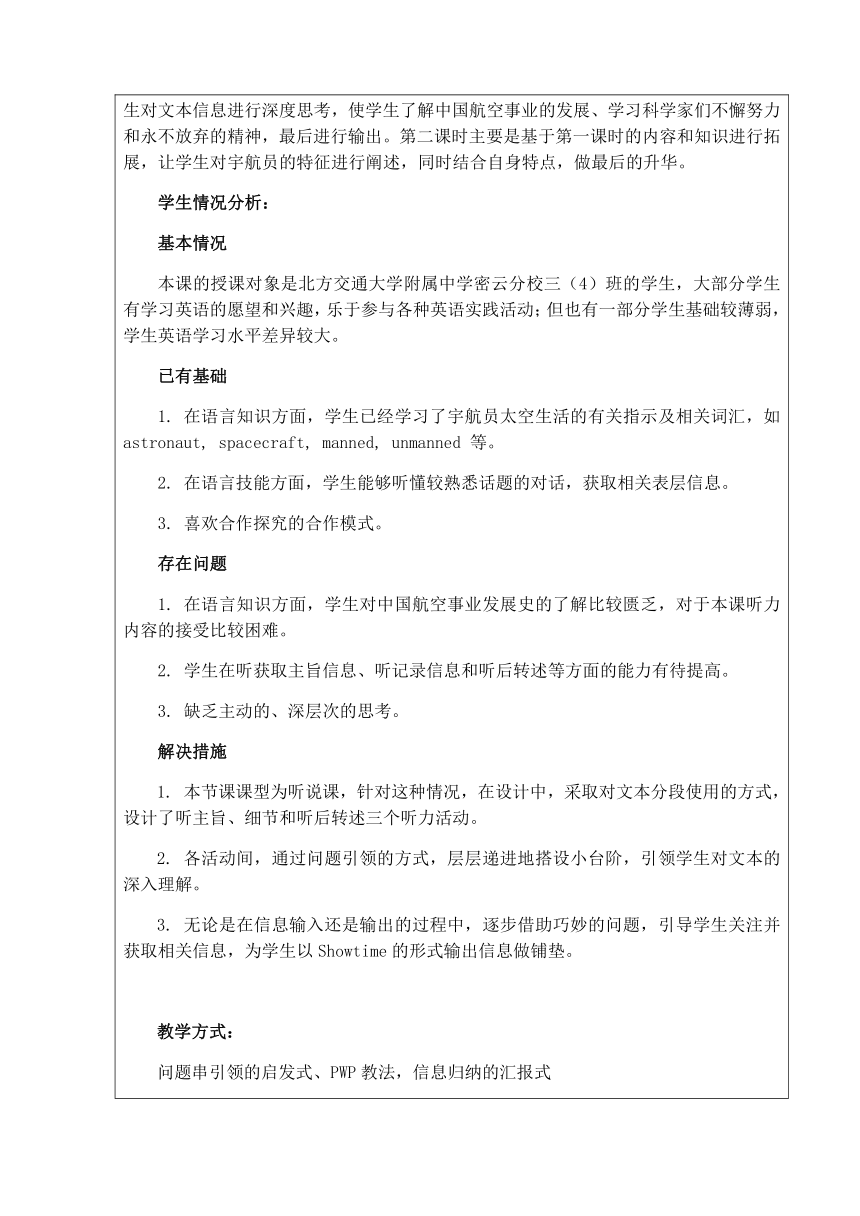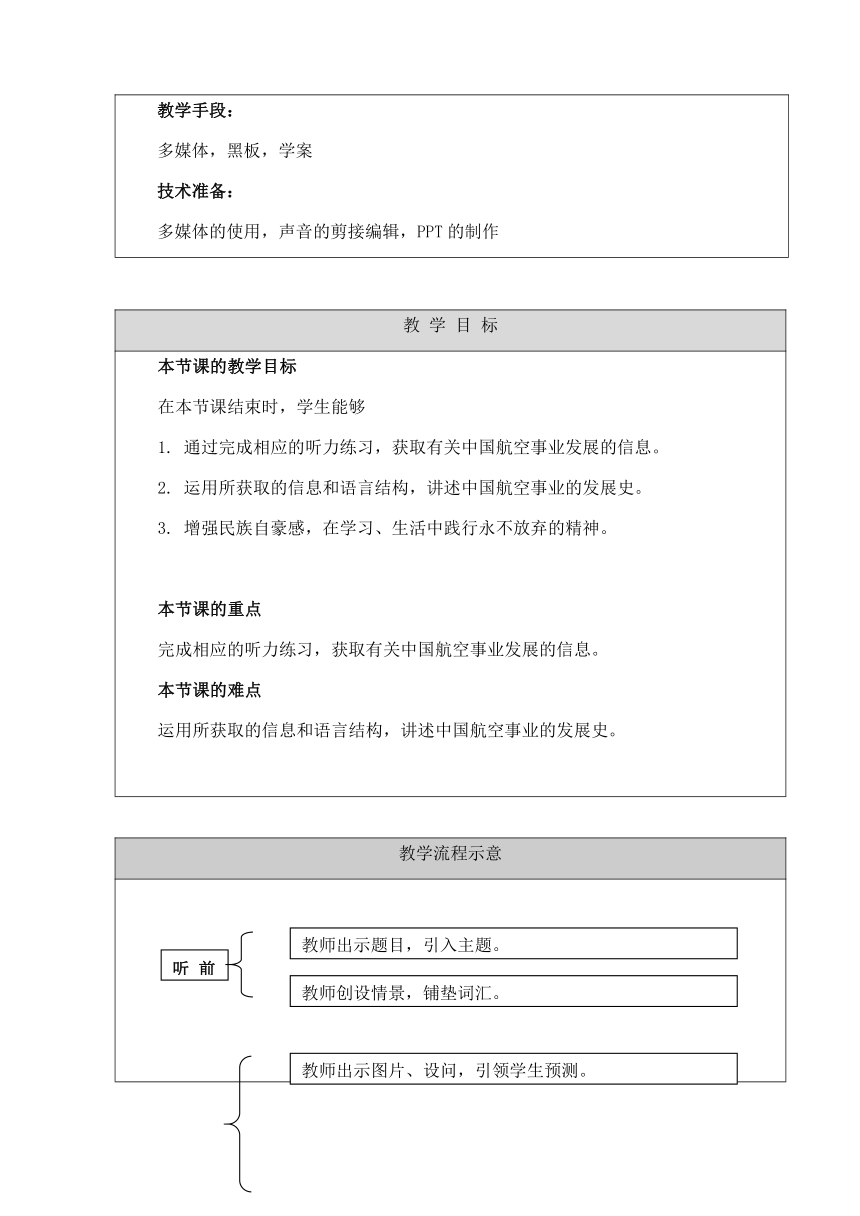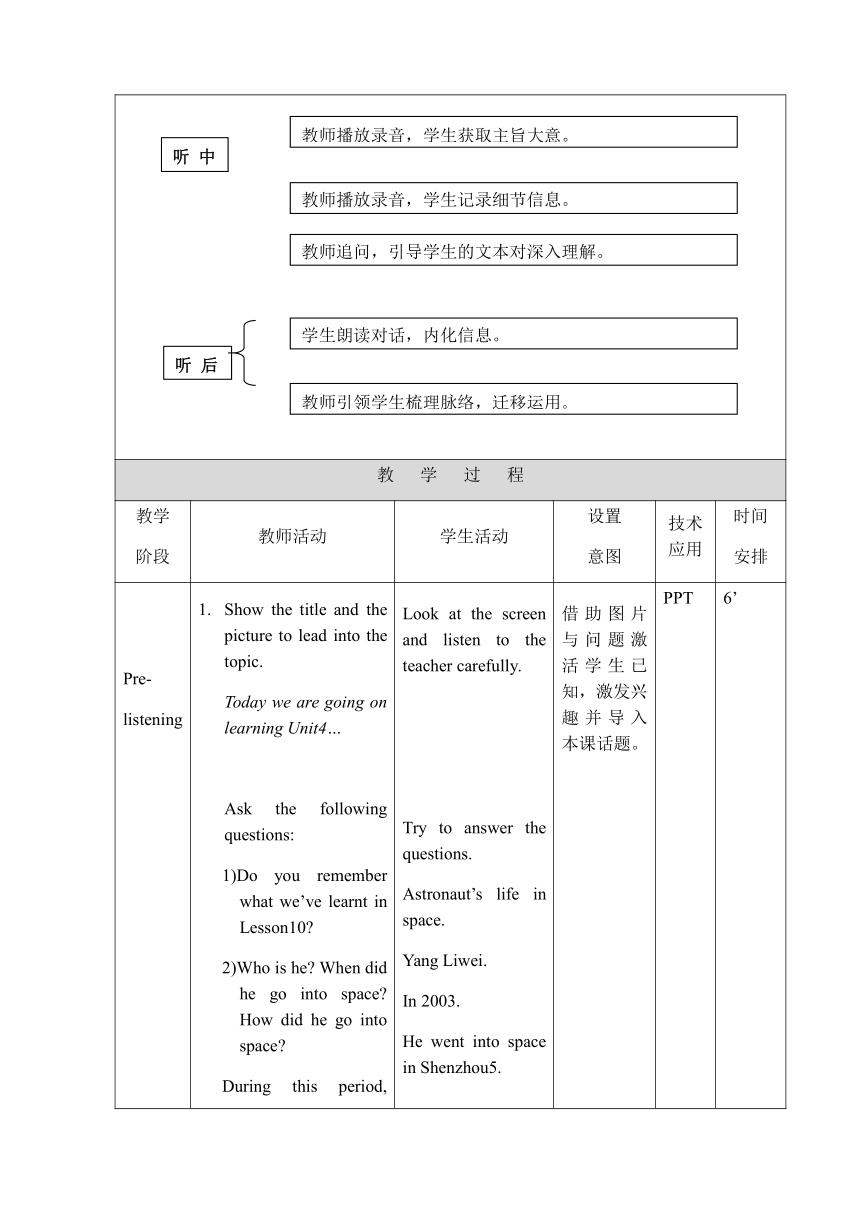北师大版英语九年级全册 Unit 4 Space Lesson 11 The Amazing Shenzhou教学设计(1课时)
文档属性
| 名称 | 北师大版英语九年级全册 Unit 4 Space Lesson 11 The Amazing Shenzhou教学设计(1课时) |  | |
| 格式 | zip | ||
| 文件大小 | 91.5KB | ||
| 资源类型 | 教案 | ||
| 版本资源 | 北师大版 | ||
| 科目 | 英语 | ||
| 更新时间 | 2020-02-16 21:16:39 | ||
图片预览





文档简介
教学基本信息
课题 Unit 4 Lesson11 The Amazing Shenzhou
学科 英语 学段: 初中 年级 九年级
相关领域 国家与民族;发明与技术;中国历史与世界历史
教材 书名:英语 出版社:北京师范大学出版社 出版日期: 2017年7 月
指导思想与理论依据
以《英语课程标准》(2011年版)和本教材主编王蔷教授《英语学科核心素养培养背景下对教学设计的再思考》报告为本课设计依据。《英语课程标准》(2011年版)指出义务教育英语课程既承担着培养学生基本英语素养和发展学生思维能力的任务,也承担着提高学生综合人文素养的任务,帮助他们形成良好的品格和正确的人生观和价值观。王蔷教授在《英语学科核心素养培养背景下对教学设计的再思考》报告中提倡学生的学习方式要走向整合、关联、发展的课程,实现对语言的深度学习(即语言、文化、思维的融合)。融育人目标于教学内容与教学过程之中。教师要在主题意义探究和解决问题的活动中,整合语言知识学习和语言技能发展,体现文化感知和品格塑造,发展思维品质和语言能力。本课是一节听说课,内容是中国航空事业发展史。听说过程中,以语篇内容为依托,以主题意义为引领,以获取中国航空事业发展史为明线,以增强民族自豪感、学习航天人永不放弃的精神为暗线,引领学生体会成功需要努力、需要合作。在课堂活动过程中,学生建构信息、发展思维、升华情感。
教学背景分析
教学内容分析:本课是北师大版初中英语九年级第四单元的第二课。本单元的话题是太空,本课是在第一课介绍宇航员太空生活的有关知识的基础上,以对话的形式,对中国的太空事业进行阐述。本课标题是The Amazing Shenzhou。本课为听说课。本课的听力材料为Dr Wang 和主持人的对话,主要是对中国的航空事业发展史进行介绍。根据教材文本设置,首先要求学生要对对话中的内容有大概的了解;同时,根据对话中出现的人造卫星的名称,要求学生记录年份;并通过问题引领学生对文本信息进行深度思考,使学生了解中国航空事业的发展、学习科学家们不懈努力和永不放弃的精神,最后进行输出。第二课时主要是基于第一课时的内容和知识进行拓展,让学生对宇航员的特征进行阐述,同时结合自身特点,做最后的升华。学生情况分析:基本情况本课的授课对象是北方交通大学附属中学密云分校三(4)班的学生,大部分学生有学习英语的愿望和兴趣,乐于参与各种英语实践活动;但也有一部分学生基础较薄弱,学生英语学习水平差异较大。已有基础在语言知识方面,学生已经学习了宇航员太空生活的有关指示及相关词汇,如astronaut, spacecraft, manned, unmanned 等。在语言技能方面,学生能够听懂较熟悉话题的对话,获取相关表层信息。喜欢合作探究的合作模式。存在问题在语言知识方面,学生对中国航空事业发展史的了解比较匮乏,对于本课听力内容的接受比较困难。学生在听获取主旨信息、听记录信息和听后转述等方面的能力有待提高。缺乏主动的、深层次的思考。解决措施本节课课型为听说课,针对这种情况,在设计中,采取对文本分段使用的方式,设计了听主旨、细节和听后转述三个听力活动。各活动间,通过问题引领的方式,层层递进地搭设小台阶,引领学生对文本的深入理解。无论是在信息输入还是输出的过程中,逐步借助巧妙的问题,引导学生关注并获取相关信息,为学生以Showtime的形式输出信息做铺垫。 教学方式:问题串引领的启发式、PWP教法,信息归纳的汇报式教学手段:多媒体,黑板,学案技术准备:多媒体的使用,声音的剪接编辑,PPT的制作
教 学 目 标
本节课的教学目标在本节课结束时,学生能够通过完成相应的听力练习,获取有关中国航空事业发展的信息。运用所获取的信息和语言结构,讲述中国航空事业的发展史。增强民族自豪感,在学习、生活中践行永不放弃的精神。 本节课的重点完成相应的听力练习,获取有关中国航空事业发展的信息。本节课的难点运用所获取的信息和语言结构,讲述中国航空事业的发展史。
教学流程示意
教 学 过 程
教学阶段 教师活动 学生活动 设置意图 技术应用 时间安排
Pre-listening Show the title and the picture to lead into the topic. Today we are going on learning Unit4…Ask the following questions:1)Do you remember what we’ve learnt in Lesson10?2)Who is he? When did he go into space? How did he go into space? During this period, teach citizen, launch. 3) What’s this?Yes, so today we are going to learn Lesson 11 The Amazing Shenzhou. Shenzhou is so important about China’s space programme. Free talk:Show some pictures and ask the following questions. 1)What do you know about China’s space programme?2) When did it begin? 3) Have you seen these pictures? Do you know the names of them?During this period, teach satellite. Look at the screen and listen to the teacher carefully. Try to answer the questions.Astronaut’s life in space.Yang Liwei. In 2003. He went into space in Shenzhou5. Learn the word citizen, launch. It’s Shenzhou 5. Look at the pictures and try to talk about something about China’s space programme. Look at the pictures and say out the names of the spacecrafts.Learn the words satellite. 借助图片与问题激活学生已知,激发兴趣并导入本课话题。 随着进度的推进,教授听力中影响理解的词汇。 借助问答,导入本课主题。 激活学生的背景知识,抛出问题,激发学习兴趣。提出最终要解决的问题,引导学生全程关注。 教授听力中影响理解的词汇。 PPT black-board PPT black-board 6’
While-listening First-listening:Show a picture and ask the following questions:1)What are they doing?2)Who is the host? 3)What are they going to talk about? Play the recording twice, have students listen and check their predictionsCheck the answers and focus on the reasons about these questions:2)Who is the host? 3)What are they going to talk about? 追问 ☆Who is the woman? Second-listeningListen for the detailed information about the history of China’s space programme.1)Have students underline the key words first.During this period, teach achievement, female. 2)Play the recording twice. 3)Check the answers. 追问☆Why was Tiangong1 another achievement?If necessary, play the related recording.☆How does Dr Wang tell us all the information about China’s space programme?4)Do a short retell. 追问☆Are you proud of our country? Look at the picture and try to answer the questions:1)They are doing an interview.2)The man is the host. From the paper before him.3)Maybe they are going to talk about the space/ spacecrafts...Listen and try to check their predictions. Check the answers and try to tell the reasons:2)The man is the host, because the first voice is a man’s, and he said “Hello Listeners. Welcome to Science this week”.3)They are going to talk about the history of China’s space programme.(She is Dr Wang.) Underline the key words on their own. Learn the words achievement, female. Listen and jot down the years and more useful information. Check the answers by saying out the whole sentences. (Because it showed China’s ability to build space station.) Think over and try to work out the answer: years/times/ timeline. Retell the history of China’s space programme with the teacher’s help. 引导学生进行听前预测,渗透听力策略。 通过核对答案,引导学生积极使用听力策略。 通过核对答案,引领学生获取主旨信息。 教授听力中影响理解的词汇。 通过培养学生运用听力记录信息的正确方式,引领学生获取细节信息。通过核对答案,层层追问,引领学生获取深层次信息,了解中国航空事业的发展。 引导学生与文本、与作者进行深层次交互,感受作者的写作意图和手法。 借助板书信息,内化所学语言,为输出最准备。 问题引领,增强学生的民族自豪感。 PPT multi-media Multi-media PPT black-board Multi-media black-board 4’ 15’
Post-listening Reading timePlay the whole recording twice, and have students listen and read in a low voice.Have students read by themselves. Further thinking.追问☆Did America start their space programme earlier than China’s? Why?☆What do you think of Chinese scientists?☆What should you learn from them? During this period, teach effort. Show Time:Show a task and do an example. Imagine you are an exchange student giving a speech to teenagers in America. Tell them something about China’s space programme.Have students prepare by themselves.Have the show. Summary1)What have you learnt in this class? 2)How long is the history of it?3)Is Dongfanghong 1manned or unmanned?How do you know? Listen and read in a low voice. Read aloud individually. Read and look for the answer for the questions.Answer the questions and give the reasons.Try to express their own opinions about China’s space programme and Chinese scientists. Learn the word effort. Read the task and try to do it with the teacher first. Then prepare for their own show.Try to introduce the history of China’s space programme and express their opinions. Summary what they have learnt in this class. 1)The history of China’s space programme.2)About 61 years.3)It is unmanned. Shenzhou 5 is the first manned spacecraft. 通过跟读录音,引导学生模仿正确的语音语调;通过朗读对话,进一步理解文本。通过追问,引导学生进一步感知航空事业发展史和航空人士的伟大,提升学生的民族自豪感。 教授影响理解的词汇。 复现本课重点词汇和文本框架,结合板书,创设情境,引导学生运用所学语言讲述中国航空事业发展史。 通过引导学生梳理总结,增强学生民族自豪感,在学习、生活中践行永不放弃的精神。 Multi-media PPT black-board PPT black-board black-board 10’ 7’ 2’
Home-work Read the conversation twice, pay attention to the pronunciations.Write down their own retelling about China’s space programme. Look and remember the homework. 从口头练习到笔头练习,巩固所学。 PPT 1’
学习效果评价设计
我知道了 OK Good Excellent
1.有关中国航空事业发展史的如下信息:1)中国航空事业开始于1956年,比美国晚了五十年。2)中国的第一颗卫星是东方红一号,发射于1970年。3)中国的第一课载人飞船是神舟五号,发射于2003年。4)天宫一号展现了中国建造宇宙空间站的能力。5)中国第一位女宇航员于2012年乘神舟9号进入太空。
2.中国航空事业虽然起步晚于美国,但在科学家们的努力与坚持下取得了非常大的进展。
3.任何目标的达成都需要刻苦的努力,我为中国的航空事业和航天工作者们感到自豪,我将学习他们永不放弃的精神。
本教学设计与以往或其他教学设计相比的特点(300-500字数)
本教学设计与以往教学设计相比的特点如下:首先,以主题意义为引领,以语篇为依托,发展学生思维。教师一直在以问题串的形式引领学生建构语篇意义。并且本课的板书也是随着教学进度的不断深入,适时巧妙地呈现;最终通过教师的问题引领学生与文本互动、与作者互动,借助问题How does Dr Wang tell us the history of China’s space programme?的引领,让学生关注文本的呈现方式——根据航空事业的发展时间来呈现信息,帮助学生总结出timeline一词,最后将本课所有重点板书借助一条timeline完整的呈现在黑板上,引领学生关注语篇意义的同时,明确语篇结构,建构学生对文本的深入理解,引领学生的思维过程。其次,基于学情设计听说活动。本课听力活动的设计均基于学情,对大段的文本材料进行剪辑,降低听力材料的难度;同时听前的方法点拨清晰到位,照顾到不同层面的学生;为引领学生用所学语言做事情,教学过程边输入、边内化、边引领学生使用整句,由简单到复杂谈论中国航空事业发展史,效果明显,目标达成度高。最后,注重朗读训练。本课听力文本的朗读充分。采用站着朗读的方式,学生的精神更专注,声音更洪亮;且朗读之后的追问,让学生解决了听不能解决的问题,深入挖掘文本信息,为之后的输出做足铺垫。
板书设计
Lesson 11 The Amazing Shenzhou the history of China’s space programme ≈61years in 1956 1970 1999 2003 2011 2012 2016 Satellite 2017 Dongfanghong 1 timeline
听 前
教师出示题目,引入主题。
教师创设情景,铺垫词汇。
教师出示图片、设问,引领学生预测。
教师播放录音,学生获取主旨大意。
听 中
教师播放录音,学生记录细节信息。
教师追问,引导学生的文本对深入理解。
学生朗读对话,内化信息。
听 后
教师引领学生梳理脉络,迁移运用。
ability to build space station
Shenzhou 9
Tiangong 1
another
achievement
Shenzhou 11
... launched
...began
Shenzhou 1
1st female
astronaut
Shenzhou 9
Shenzhou 5
1st Chinese
citizen
同课章节目录
- Unit 1 Language
- Lesson 1 Body Language
- Lesson 2 Different Kinds of Language
- Lesson 3 Language Learning Tips
- Communication Workshop
- Unit 2 Books
- Lesson 4 Classics
- Lesson 5 The Book Club
- Lesson 6 Tom Sawye
- Communication Workshop
- Unit 3 Creativity
- Lesson 7 A Famous Invento
- Lesson 8 Good or Bad?
- Lesson 9 Creative Minds
- Communication Workshop
- Unit 4 Space
- Lesson 10 Life in Space
- Lesson 11 The Amazing Shenzhou
- Lesson 12 The Spaceship
- Communication Workshop
- Unit 5 Literature
- Lesson 13 Anne of Green Gables
- Lesson 14 The Dark Room
- Lesson 15 A Famous Write
- Communication Workshop
- Unit 6 Role Models
- Lesson 16 Yao Ming
- Lesson 17 People in Our Lives
- Lesson 18 Steve Jobs
- Communication Workshop
- Unit 7 Journeys
- Lesson 19 The Silk Road
- Lesson 20 Life in a Journey
- Lesson 21 To the South Pole
- Communication Workshop
- Unit 8 Discoveries
- Lesson 22 Famous Discoveries
- Lesson 23 Discovery of the Yea
- Lesson 24 An Experiment Report
- Communication Workshop
- Unit 9 Save the Planet
- Lesson 25 Going Green
- Lesson 26 Our Rive
- Lesson 27 Tree Heroes
- Communication Workshop
